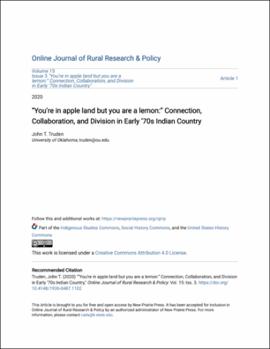| dc.contributor.author | Truden, John | |
| dc.date.accessioned | 2021-01-04T23:25:22Z | |
| dc.date.available | 2021-01-04T23:25:22Z | |
| dc.date.issued | 2020-07-01 | |
| dc.identifier.citation | John Truden, "'You’re in apple land but you are a lemon:' Connection, Collaboration, and Division in Early ‘70s Indian Country," Online Journal of Rural Research & Policy 15/3 (July 2020), https://doi.org/10.4148/1936-0487.1102 | en_US |
| dc.identifier.uri | https://hdl.handle.net/11244/326696 | |
| dc.description.abstract | In the first years of the 1970s, Indian Country became paradoxically more interwoven and yet also more divided. Three case studies from Oklahoma’s Indigenous communities illustrate this transformation. Beginning in the mid-1960s, a boom in Indigenous media allowed Indigenous people to communicate far more quickly over once prohibitive distances. In western Oklahoma, Southern Cheyenne parents relied upon Navajo ideas to form their own indigenous controlled school in early 1973. As a result of these exchanges between previously removed people, new indigenous communities emerged along ideological lines rather than those of tribal citizenship or ethnic identity. A few months earlier, the National Indian Youth Council’s Oklahoma chapters, one such evolving ideological community out of many in the United States, successfully brought attention to and changed a key state policy affecting indigenous students in public schools. Even as Indigenous activists collaborated with new vigor, corresponding divisions emerged in existing Indigenous communities; Native people began to debate the meaning of the messages new communities popularized. The American Indian Movement attempted to hold its 1973 national convention at Pawnee, Oklahoma, only to find that Indigenous people in the region did not support the gathering as the movement’s leaders anticipated. Together, these three case studies present a portrait of a diverse, indigenous world that facilitated collaboration through Native media yet wrought with emerging ideological schisms. | en_US |
| dc.description.sponsorship | Originally published in the Online Journal of Rural Research and Policy | en_US |
| dc.language | en_US | en_US |
| dc.rights | Attribution 4.0 International | * |
| dc.rights.uri | https://creativecommons.org/licenses/by/4.0/ | * |
| dc.subject | History, Modern | en_US |
| dc.subject | History, United States. | en_US |
| dc.subject | Native American Studies. | en_US |
| dc.subject | Journalism. | en_US |
| dc.subject | Oklahoma | en_US |
| dc.subject | American Indian Movement | en_US |
| dc.subject | National Indian Youth Council | en_US |
| dc.subject | Education, Bilingual and Multicultural. | en_US |
| dc.subject | Iranian Revolution | en_US |
| dc.subject | United Native Indian Tribal Youth | en_US |
| dc.subject | Nineteen Seventies | en_US |
| dc.subject | Southern Cheyenne | en_US |
| dc.subject | Northern Cheyenne | en_US |
| dc.subject | Dine (Navajo) | en_US |
| dc.subject | Coalition of Indian Controlled School Boards | en_US |
| dc.subject | Johnson O'Malley | en_US |
| dc.subject | Education, History of. | en_US |
| dc.subject | Oklahoma City | en_US |
| dc.subject | Wounded Knee | en_US |
| dc.subject | International Indian Treaty Council | en_US |
| dc.subject | Indigenous Newspapers | en_US |
| dc.subject | The Institute of the Southern Plains | en_US |
| dc.subject | Dine College (Navajo Community College) | en_US |
| dc.subject | Northern Cheyenne Tribal Schools | en_US |
| dc.subject | Police Brutality | en_US |
| dc.subject | Americans Before Columbus | en_US |
| dc.subject | Trail of Broken Treaties | en_US |
| dc.subject | Red Power | en_US |
| dc.subject | Tulsa American Indian Movement | en_US |
| dc.subject | Tulsa | en_US |
| dc.subject | Hammon | en_US |
| dc.subject | Yale, Oklahoma | en_US |
| dc.subject | Pawnee Nation | en_US |
| dc.subject | Pawnee, Oklahoma | en_US |
| dc.subject | Durango, Colorado | en_US |
| dc.subject | Busby, Montana | en_US |
| dc.subject | White Oak, Oklahoma | en_US |
| dc.title | “You’re in apple land but you are a lemon:” Connection, Collaboration, and Division in Early ‘70s Indian Country | en_US |
| dc.type | Article | en_US |
| dc.description.peerreview | Yes | en_US |
| dc.description.peerreviewnotes | The Online Journal of Rural Research and Policy (this article's original place of publication) uses a double blind peer review process. I received and responded to notes from two anonymous peer reviewers. My article was then accepted by the editor of OJRRP for publication. | en_US |
| dc.identifier.doi | https://doi.org/10.4148/1936-0487.1102 | en_US |
| ou.group | College of Arts and Sciences::Department of History | en_US |

